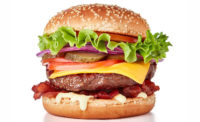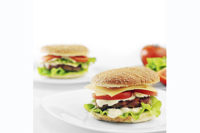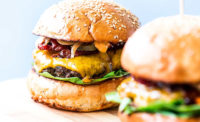The simple hamburger is a grand opportunity for any chef to don their mad scientist lab coat and get as creative as possible. Read a description of a burger in many restaurants, and you are likely to find exotic toppings, multiple proteins or consumer-friendly buzzwords. Or a tarantula. Yes, a North Carolina restaurant offered a hamburger earlier this year that was topped with an oven-roasted spider. An arachno-burger may be pushing the boundaries a bit, but there are many ways that restaurants and processors can make their burger stand out.
David “Rev” Ciancio, director of industry insights at Yext, says that consumer expectations have evolved and grown around the quality and the sourcing of the product. Ciancio is a marketing strategist with an expertise in burgers, and he is the founder of New York Burger Week. He cautions that there is a disconnect between the consumer’s awareness of buzzwords and their importance.
“I think people start to hear words like organic, or brisket, or grass-fed or all-natural, and it sounds almost romantic. And it’s just enough to get them to believe it’s better, but I don’t feel like the general populace is out there actually getting education to back up how they feel about these things,” he says. “I’m hoping that’s what the future is, and I think that’s where we’re going, that people will actually start to take the time to understand what goes into these buzzwords.”
Buzzwords and intriguing descriptors are a good way to attract consumer attention. In New York City, Ciancio says that more burger restaurants are adding a “dry-aged” burger to their menu.
“After the bust of 2009, people were not going out and spending opulent amounts of money on steak dinners, and so hamburger became the new steak,” he explains. “Restauranteurs and chefs started to figure how to satisfy somebody with something that’s just as succulent and desirable but that doesn’t have the price tag. I think dry aging has filled that void a little bit.”
Ciancio also notes that the trend toward big burger patties is starting to change. A restaurant that may have once offered a massive 8-ounce patty is now going with a 2- or 3-ounce burger, or two smaller patties instead of one larger one. There are several advantages to the smaller burger. One practical reason is that a smaller patty is easier and faster to prepare when compared to a larger patty, so the food gets to the customer faster. A smaller burger patty also can result in a better eating experience.
“From a taste perspective, what we really like about a hamburger is the Maillard reaction,” Ciancio says, referring to the chemical reaction that causes browned meat to have a distinctive flavor. “When you have two patties, there’s more surface to sear. There’s more flavor.”
On the retail side, it’s more difficult to produce a truly unique product, since so much of the beef comes from a handful of packers. Meat processors have to call out the attributes of the product, whether it’s a specific cut of beef, a specific species of cow or a specific attribute like grass-fed or antibiotic free.
Ciancio says that processors can differentiate themselves by other means, namely customer service and branding. Branding is particularly important, he adds. Consumers choose one company over another because something about that company speaks to them. Assuming that product quality is similar, the company that succeeds is the one that presents the best message.
“I think it comes down to branding, and I think that manufacturers that want to stand out and continue to excel in the business will spend some time on branding and establishing what those brand values are and who are the types of customers they work with,” he says.
Stunt Burgers
Ciancio has a popular Instagram account (@revciancio) where he features photos some of the wildest and tastiest burgers he’s seen — or designed himself, in some cases. While smaller patties and good customer service make for steady sales and happy customers, there is something to be said about the stunt burger — that glorious, oversized, three-napkin mess of a burger that presents wild new tastes and ingredients.
As a founder of New York Burger Week, Ciancio has seen more than his share of stunt burgers. One event at this year’s Burger Week included a series of burgers designed after The Avengers, Marvel Comics’ group of superheroes. One such burger, created in honor of Dr. Strange, featured bright green onion rings designed to resemble his “Eye of Agamotto” amulet.
Ciancio admits that a “stunt burger” doesn’t always taste good, even if it looks great in an Instagram pic. Burgers that combine an innovative concept with an excellent taste give the customer the best of both worlds. Ciancio mentioned one meal he enjoyed at New York City’s Flattopps, where the burger came with a bun made from cheesy tater tots instead of bread. Then there was the blueberry and brie burger and the bacon macaroni and cheese burger at Jackson Hole on 3rd Avenue.
“They’ve done a really great job of taking that innovative-type aspect and not gotten crazy with it, and not gotten over the line,” he says.
In other words, no tarantulas.








